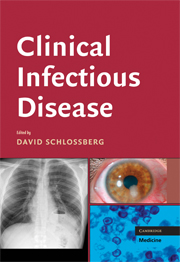Book contents
- Frontmatter
- Contents
- Preface
- Contributors
- Part I Clinical Syndromes – General
- Part II Clinical Syndromes – Head and Neck
- Part III Clinical Syndromes – Eye
- Part IV Clinical Syndromes – Skin and Lymph Nodes
- 17 Fever and Rash
- 18 Staphylococcal and Streptococcal Toxic Shock and Kawasaki Syndromes
- 19 Classic Viral Exanthems
- 20 Skin Ulcer and Pyoderma
- 21 Cellulitis and Erysipelas
- 22 Deep Soft-Tissue Infections: Necrotizing Fasciitis and Gas Gangrene
- 23 Human and Animal Bites
- 24 Lice, Scabies, and Myiasis
- 25 Superficial Fungal Diseases of the Hair, Skin, and Nails
- 26 Mycetoma (Madura Foot)
- 27 Fever and Lymphadenopathy
- Part V Clinical Syndromes – Respiratory Tract
- Part VI Clinical Syndromes – Heart and Blood Vessels
- Part VII Clinical Syndromes – Gastrointestinal Tract, Liver, and Abdomen
- Part VIII Clinical Syndromes – Genitourinary Tract
- Part IX Clinical Syndromes – Musculoskeletal System
- Part X Clinical Syndromes – Neurologic System
- Part XI The Susceptible Host
- Part XII HIV
- Part XIII Nosocomial Infection
- Part XIV Infections Related to Surgery and Trauma
- Part XV Prevention of Infection
- Part XVI Travel and Recreation
- Part XVII Bioterrorism
- Part XVIII Specific Organisms – Bacteria
- Part XIX Specific Organisms – Spirochetes
- Part XX Specific Organisms – Mycoplasma and Chlamydia
- Part XXI Specific Organisms – Rickettsia, Ehrlichia, and Anaplasma
- Part XXII Specific Organisms – Fungi
- Part XXIII Specific Organisms – Viruses
- Part XXIV Specific Organisms – Parasites
- Part XXV Antimicrobial Therapy – General Considerations
- Index
22 - Deep Soft-Tissue Infections: Necrotizing Fasciitis and Gas Gangrene
from Part IV - Clinical Syndromes – Skin and Lymph Nodes
Published online by Cambridge University Press: 05 March 2013
- Frontmatter
- Contents
- Preface
- Contributors
- Part I Clinical Syndromes – General
- Part II Clinical Syndromes – Head and Neck
- Part III Clinical Syndromes – Eye
- Part IV Clinical Syndromes – Skin and Lymph Nodes
- 17 Fever and Rash
- 18 Staphylococcal and Streptococcal Toxic Shock and Kawasaki Syndromes
- 19 Classic Viral Exanthems
- 20 Skin Ulcer and Pyoderma
- 21 Cellulitis and Erysipelas
- 22 Deep Soft-Tissue Infections: Necrotizing Fasciitis and Gas Gangrene
- 23 Human and Animal Bites
- 24 Lice, Scabies, and Myiasis
- 25 Superficial Fungal Diseases of the Hair, Skin, and Nails
- 26 Mycetoma (Madura Foot)
- 27 Fever and Lymphadenopathy
- Part V Clinical Syndromes – Respiratory Tract
- Part VI Clinical Syndromes – Heart and Blood Vessels
- Part VII Clinical Syndromes – Gastrointestinal Tract, Liver, and Abdomen
- Part VIII Clinical Syndromes – Genitourinary Tract
- Part IX Clinical Syndromes – Musculoskeletal System
- Part X Clinical Syndromes – Neurologic System
- Part XI The Susceptible Host
- Part XII HIV
- Part XIII Nosocomial Infection
- Part XIV Infections Related to Surgery and Trauma
- Part XV Prevention of Infection
- Part XVI Travel and Recreation
- Part XVII Bioterrorism
- Part XVIII Specific Organisms – Bacteria
- Part XIX Specific Organisms – Spirochetes
- Part XX Specific Organisms – Mycoplasma and Chlamydia
- Part XXI Specific Organisms – Rickettsia, Ehrlichia, and Anaplasma
- Part XXII Specific Organisms – Fungi
- Part XXIII Specific Organisms – Viruses
- Part XXIV Specific Organisms – Parasites
- Part XXV Antimicrobial Therapy – General Considerations
- Index
Summary
Necrotizing fasciitis (NF) and gas gangrene (GG) are serious infections of the deep soft tissue. They both carry a high morbidity and mortality. Early diagnosis and treatment is important and is the key to improving outcome. Broadly speaking, NF is an infection primarily of the fascia and deep soft tissue of the skin, whereas GG is usually an infection of the skeletal muscle.
Previously, NF has been subdivided into different categories based on anatomical site, but such classification is not helpful regarding the diagnosis and management of these dangerous conditions. Both GG and, particularly, NF are strongly associated with numerous underlying, premorbid risk factors (Table 22.1), each of which requires medical management to improve the prognosis of an individual patient.
Again, both conditions may be caused by one bacterial organism or, more commonly with NF, they may be polymicrobial and require treatment with broad spectrum or multiple antibiotics.
NECROTIZING FASCIITIS
Diagnosis
Necrotizing fasciitis is an uncommon, but severe, infection with a fulminant course and high mortality often following a history of trauma or surgery. The patient may go into rapid decline with necrosis of soft tissue and multisystem organ failure. The latter would appear to result from superantigenic overstimulation of the immune system and excessive production of cytokines.
- Type
- Chapter
- Information
- Clinical Infectious Disease , pp. 157 - 160Publisher: Cambridge University PressPrint publication year: 2008

